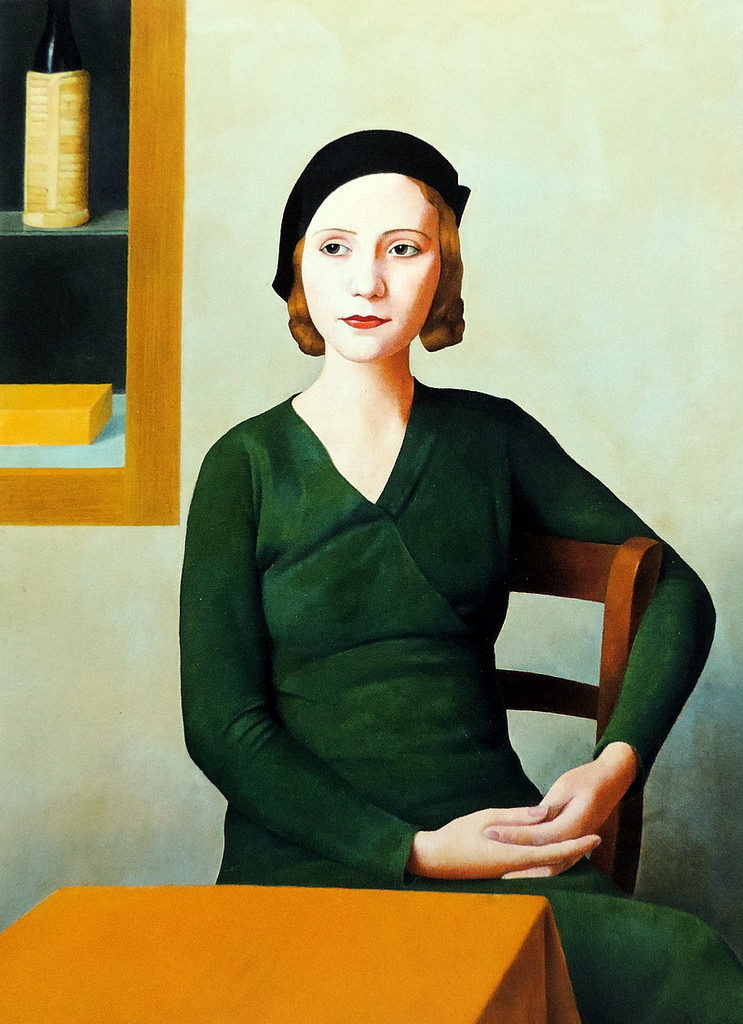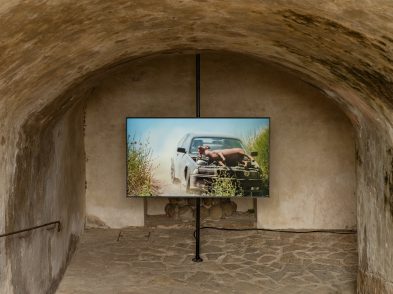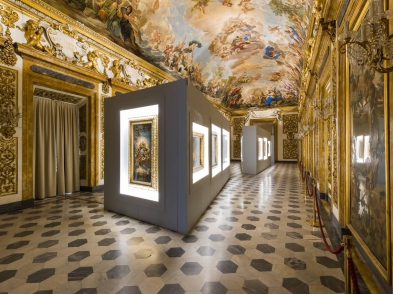Italy’s Fascist dictatorship never enforced one style on the nation’s artists. In the 1930s, therefore, traditional portraiture was practised alongside advanced abstraction in visual art and interior design. In architecture, classicism was revived for official buildings but modern streamlined structures were also built: Florence’s main railway station, opened in 1935, remains a leading example. This diversity contrasted with the realist uniformity imposed on the arts in Nazi Germany. The new exhibition at Palazzo Strozzi contains surprises and asks searching questions. Why were the arts under Mussolini able to pursue so many different forms of expression?
Looking for one artwork to promote its new exhibition of Italian art in the 1930s in posters and on buses, the organisers at Palazzo Strozzi made an intriguing choice. Their task was not straightforward. For although in its second decade Italian Fascism was politically repressive and militaristic, little attention was paid to the role of culture in serving the regime. As a result, numerous styles were practised that both looked to history and anticipated the future.
The curators chose a bold image, Woman at the Café, painted by Antonio Donghi in 1932. Perhaps the woman’s wait (for a companion, for her order?) has been longer than she would like: her attention has wandered and she has folded one arm over the chair. With her back to the wall, she has little space in which to move: between the table, the chair and the framed objects to her right, the artist has pinned her in position for the viewer’s scrutiny.
Donghi, who had been associated with the style of ‘magic realism’ and admired medieval Dutch art, heightened effects to an almost hypnotic level of visible clarity. Every part of the image is controlled and polished, from tabletop to the woman’s complexion. Sensual qualities are restrained and angles are everywhere, colour subdued and the atmosphere airless.
Time has stopped and normality seems suspended. The encounter is primarily intellectual and a little chilling, especially in comparison with another figure placed nearby in the show. Francesco Menzio’s Long-distance Runner, painted in 1930, has neither sharp outlines nor details that fix the athlete to a location. Instead, the young man could dissolve softly into his surroundings.
Or perhaps he has just emerged from them. The image exists tantalisingly between two states. Only a vase with flowers shares his space and, as if to underline the easy spirit of the piece, it seems to float against the featureless background.
Just like Donghi’s woman, the sportsman is waiting, his gaze also deflected from the viewer. But he displays no trace of tension; his calm posture suggests the imminence of his next move. He waits to get on with life and his appearance in the portrait is merely a brief distraction.
It is one contrast, and by no means the most dramatic, from a decade with no dominant style, in spite of a dictatorship in constant search of consensus. Neither painting is explicitly political and the state purchased both. So, do they reflect the reality of their time?
Donghi worked in Rome and, therefore, close to the centre of the regime. Composition and the human figure were highly praised by Fascist art commentators, and Donghi celebrated both. Regional distinctions in art, however, were as strong in Italy then as they have always been. (The last room of this show focuses on Florence, where the figurative tradition remained strong.) By eliminating any ideological content, the Turin-based Menzio registered a freer attitude-and, maybe, a subtle protest.
Geography, however, was not the key factor sustaining artistic diversity: Mussolini was. Self-taught and self-made, he had little interest in the arts. He chose not to interfere and while Nazi Germany turned art into propaganda, the Duce was mostly content to leave unmolested a sphere regarded philosophically and historically as separate from politics.
Thus, Fascist cultural policy did not promote one official style. A second wave of Futurism, celebrating speed and aviation, co-existed with a return to forms derived from Antiquity and the Renaissance. Modernist designs, like the first abstract sculpture by Lucio Fontana and Fausto Melotti, were both praised, for their order and discipline, and robustly criticised. But they were never suppressed.
And, as this show demonstrates, contacts with other art centres, especially Paris, continued once Mussolini took power in 1922. Menzio’s painting shows admiration for Matisse while expatriate (and independently-minded) Italians, like De Chirico, Campigli and De Pisis, thrived in France.
That did not mean influential people around the Duce did not try to direct Rome towards preferring one approach over others. The writer and critic Margherita Sarfatti, an intimate of Mussolini’s, boldly supported realism like Donghi did, while Roberto Farinacci, a hard-line minister, advocated Nazi-like restrictions on ‘foreign’ and ‘degenerate’ influences.
Farinacci created the Cremona Prize in which artists tackled prescribed subjects promoting the regime. In response, liberal education minister Bottai instituted a rival prize. It defended the status quo of mild Modernism and varied eclecticism that characterises the Palazzo Strozzi installation.
But, as with all intellectual activity, Fascism strove to obtain artists’ obedience. Channels such as ‘Minculpop,’ the popular name for the mass media ministry at one time headed by Count Ciano, and the web of national and regional trade unions, drew the worlds of art, architecture, film and radio into the corporate state. The most prestigious exhibitions (the Venice Biennale, above all, with high-profile shows introduced in Rome and Milan) were organised by state officials who also held the reins on public commissions and annual competitions.
The line to follow, although not stylistic, was to respect the regime’s central role in Italy’s destiny and its historical legitimacy. Such leading painters as Mario Sironi and Carlo Carrà responded sympathetically by turning their Modernist styles towards a new figuration based on Romanesque imagery and early Renaissance masters.
Sources were unimpeachably Italian and reassuringly anachronistic, and their messages, directed at everyman, depended on stark, simple forms. Sironi could conceive images on an overwhelming scale, updating the art and iconography of mural painting for didactic purposes.
Beyond that, of course, was the character of the Fascist state itself. Founded on the brutality of the squadristi, on opportunism and the cult of the superman rather than on coherent ideology, many artists gave it their support. It promised order after uncertainty and Giorgio Morandi, the master of the modern still-life painting, saw no reason to oppose Fascism, at least in the 1920s. Even its opponents were absorbed.
In the 1930s the regime became more restrictive. Censorship was operating; Ethiopia was invaded in 1935 to create an empire; Mussolini was gravitating closer to Hitler; and racial laws against Jews were introduced in 1938. Loyalties wavered among supporters: Mario Mafai’s 1939 depiction of Roman homes demolished for a new triumphal route is distinctly ambiguous in tone. Mafai’s wife was Jewish.
Visitors to the survey at Palazzo Strozzi (which itself opened as a cultural venue in 1938) are asked to set prejudices aside and look at art and design from this fascinating period through contemporaries’ eyes. And although busts of the Duce were everywhere in 1930s Italy, the familiar head and jutting chin are nowhere to be seen in the galleries. This show awkwardly and unconvincingly downplays Fascism’s pervasive presence.
What emerges from the variety is an unexpected mix of experiment and tension in the decade’s art. While not extolling Fascism, artists among the best in Europe weighed up their motives and tested the boundaries of Mussolini’s flawed totalitarianism.
A generation paid a price, sometimes reluctantly and often with great style, in impaired creative responsibility. Their legacy ignited reaction during the country’s ‘miraculous’ post-war recovery, prompting Italy’s extraordinary cultural revival.







